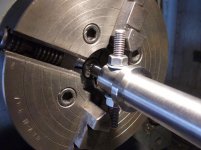erich lessing
Plastic
- Joined
- Feb 22, 2021
Hello,
I recently upgraded my 1970's model HLVH to a 2005 HLVH EM. The newer machine was missing the collet closer and chuck. My old machine was purchased with a collet closer and 3 jaw chuck installed. I destroyed the closer tube during removal from my old machine due to it being frozen in place with rust and corrosion. Also, the chuck was threaded to the closer tube. I have since purchased a replacement collet closer and am ready to reassemble the lathe. My existing spindle nose is smooth with NO threads to install the Chuck. My questions are:
1. will it destroy the collet closer if I run the lathe with the closer installed and the 3 jaw chuck hooked to it at the same time?
2. If # 1 is a bad thing, do they make a threaded adaptor for my spindle nose so I can still use my existing 3 jaw chuck?
3. What does it take to list my old HLVH on this forum to sell when I'm finished swapping these parts?
Thanks,
Erich
I recently upgraded my 1970's model HLVH to a 2005 HLVH EM. The newer machine was missing the collet closer and chuck. My old machine was purchased with a collet closer and 3 jaw chuck installed. I destroyed the closer tube during removal from my old machine due to it being frozen in place with rust and corrosion. Also, the chuck was threaded to the closer tube. I have since purchased a replacement collet closer and am ready to reassemble the lathe. My existing spindle nose is smooth with NO threads to install the Chuck. My questions are:
1. will it destroy the collet closer if I run the lathe with the closer installed and the 3 jaw chuck hooked to it at the same time?
2. If # 1 is a bad thing, do they make a threaded adaptor for my spindle nose so I can still use my existing 3 jaw chuck?
3. What does it take to list my old HLVH on this forum to sell when I'm finished swapping these parts?
Thanks,
Erich








